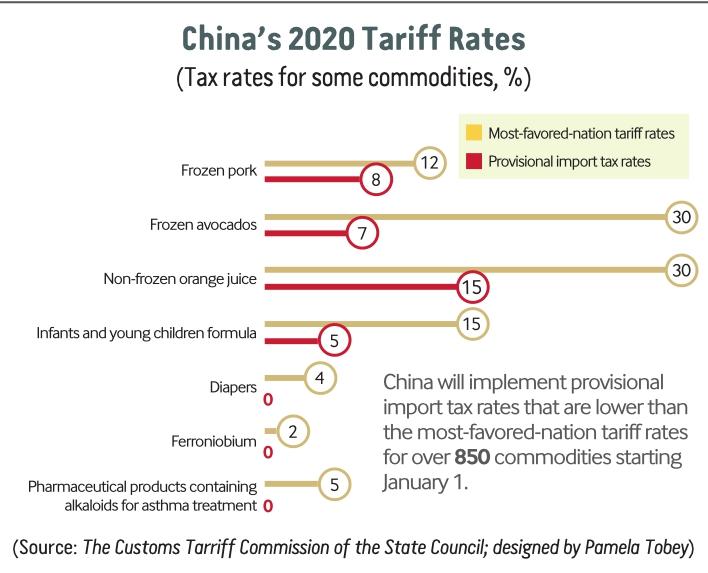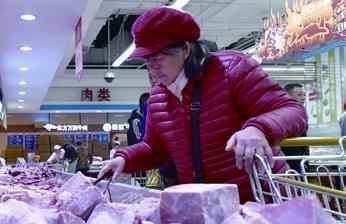Lower Tariffs,Higher Gains
2020-01-07ByMaMiaomiao
By Ma Miaomiao
As China adjusted its import tariffs for a range of products as of January 1, 2020, foreign goods will be available to domestic consumers at lower prices, according to a circular released by the Customs Tariff Commission (CTC) of the State Council. The measure aims to expand imports, promote the coordinated development of trade and the trade environment, and advance the highquality development of the country.
According to the CTC, provisional import tax rates lower than the most favored nation (MFN) tariff rates for over 850 commodities, including consumer goods, raw materials, medicines and information technology (IT) products, will be implemented to stimulate import potential and optimize the structure of imports.
The tariff adjustments will also help reduce import costs, advance opening up to a higher level and allow other countries and regions to share in Chinas development, the CTC said.

“Since China fulfi lled all of its commitments after joining the World Trade Organization (WTO), it lowered tariffs on a relatively large scale in 2018. The adjustments this time (in 2019) are another structural adjustment step to satisfying Chinas domestic needs,” Wen Laicheng, a professor at the Central University of Finance and Economics, said.
They are in line with current economic development both domestically and internationally, meeting the requirement for building Chinas high-quality economy. The benefi ts will be shared directly by consumers, businesses and other countries, Gao Lingyun, a researcher with the Institute of World Economics and Politics of the Chinese Academy of Social Sciences (CASS), told Global Times.
Meeting peoples needs
The designated items include consumer goods such as frozen pork, frozen avocados and fresh orange juice. For imported frozen pork, the tariff rate will be cut from 12 to 8 percent to increase its supply and stabilize food prices, the commission said.
Since 2018, the spread of the African swine fever virus resulted in hog levels in China falling by 41.1 percent year on year by September 2019, according to statistics from the Ministry of Agriculture and Rural Affairs. The reduced numbers led to soaring pork prices, which in turn led to a 4.5-percent year-on-year increase in the consumer price index, a main gauge of infl ation, in November 2019, according to the National Bureau of Statistics.
“China has taken various measures to restore hog production to ensure that pork supply and market prices are basically stable. Tariff reduction is one of these vital tools,”Yang Weiyong, a professor at the University of International Business and Economics in Beijing, told China Daily.
Wen echoed Yangs view. He said that the appropriate lowering of import tariffs will help keep prices down. If China relies merely on the domestic market, consumer infl ation may not decrease until the second half of 2020.
Since 2015, China has lowered import tariffs on consumer goods five times to meet peoples need for consumption upgrading. With the exception of the U.S., Chinas average tariff on products from other WTO members has been reduced to about 6.7 percent, which is almost equal to some developed countries, according to statistics provided by the Chinese Academy of International Trade and Economic Cooperation.
Chinese peoples consumption demand is now characterized by personalized, diversified and high-quality products, and the import structure will now refl ect these changes. “Importing some of the consumer goods that sell well in the Chinese market is also conducive to driving consumption,” Wen said.
Tariff reduction is acutely related to the daily life of Chinese people. For that reason, a zero import tax on pharmaceutical products containing alkaloids for asthma treatment as well as raw materials for the production of new diabetes medicines will also be implemented to reduce medication costs and promote the production of new medicines.
Medical consumption in China is an expanding market, partly due to the large size and aging of Chinas population, Wei Hao, a professor with Beijing Normal University, told 21st Century Business Herald. The number of patients with diabetes and hypertension is expanding rapidly in China. “In many sectors, domestic supply of medicine and medical services is inadequate, and expanding imports will help alleviate this problem,” he explained.
In recent years, China has lowered tariffs on anti-cancer drugs, raw materials used for medicines and drugs for rare diseases. This time, it chose to lower tariffs on drugs for chronic diseases, which will further help reduce the cost of medicines for patients and ease their burden, Wei added.
Better opening up
The Central Economic Work Conference for 2020 held in December 2019, called for greater efforts to increase imports and exports, push for a more diversified export market and cut institutional costs for imports, with the aim of promoting free trade and safeguarding the multilateral trading system.
In 2020, agreed-upon rates will be applied on products from 23 countries and regions in accordance with Chinas free trade commitments. According to free trade agreements with 11 separate countries, such as New Zealand, Peru and Australia, as well as the Asia-Pacific Trade Agreement involving seven nations, goods will have even lower levies.
China will continue to apply preferential tariff rates to goods from the least developed countries in the world that have established diplomatic ties and completed the exchange of notes on the establishment of diplomatic relations with China. Adjustments will also be made to applicable countries in line with the United Nations list of the least developed countries and Chinas transition period arrangements, the commission said.
Free trade agreements or preferential trade arrangements are often reciprocal. “When China reduces import tariffs, relevant countries often take corresponding measures, which will have a positive impact on bilateral trade,” Yang Zhiyong, a researcher with the National Academy of Economic Strategy of CASS, said.

At the same time, these adjustments will also play a positive role in promoting Belt and Road cooperation, building a high standard free trade zone network and promoting a higher level of opening up, Yang Zhiyong added.
Amid rising trade protectionism, China hosted the Second China International Import Expo which attracted more than 180 countries, regions and international organizations and over 3,800 global enterprises in November 2019, which showed that the country is committed to not only increasing imports to meet peoples evergrowing need for a better life but also further opening up its economy to the world.
Sluggish global growth may continue to create headwinds for Chinese exports in 2020, but Louis Kuijs, head of Asia Economics at Oxford Economics, predicted that a sequential import momentum will moderately pick up after inventory destocking of heavy industries, according to China Daily.
Chinas import growth, which was 0.3 percent in November 2019, registering the fi rst positive year-on-year growth since May 2019, is likely to stay in solid positive territory for the near term, Kuijs said.
Boosting development
MFN tariff rates on 176 IT items will be further reduced and the provisional import tariff rates on some IT products will be adjusted accordingly starting on July 1.
It will be the fifth such cut since December 2015, when 24 WTO members, including China, the U.S. and Japan, agreed to expand the covered product range within the Information Technology Agreement, which stated that tariffs on some IT products will be gradually eliminated.
China is one of the worlds major importers and exporters of IT products; thus, cutting import tariffs on these items can help reduce manufacturing costs for many domestic producers and enhance their competitiveness, Gao said. It is conducive to the economys high-quality development and the upgrading of manufacturing in the future, he added.
The commissions statement noted that tariffs on some hi-tech components, such as semiconductor testing and sorting equipment, and automobile transmissions parts, will be temporarily cut to strengthen sectors such as integrated circuit, aerospace, automobile and telecommunication production.
Since the beginning of 2019, the U.S. has attempted to pressure Chinese companies by cutting off their supply of core components, technologies and raw materials. Chinas move to lower tariffs will help to reduce operating and procurement costs for these businesses as well as promote its industrial transformation and upgrading, Wei said.
